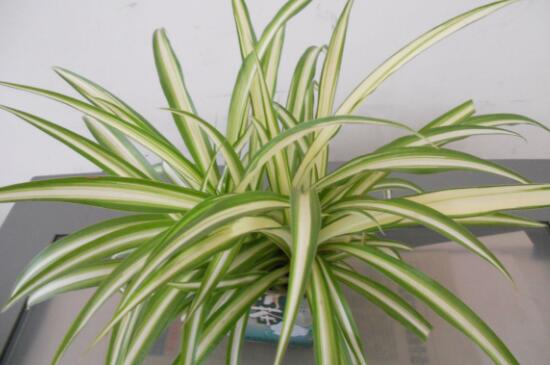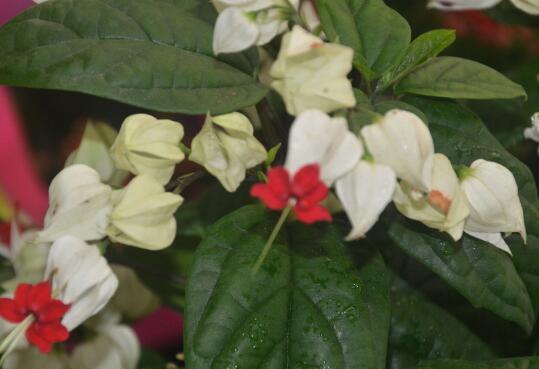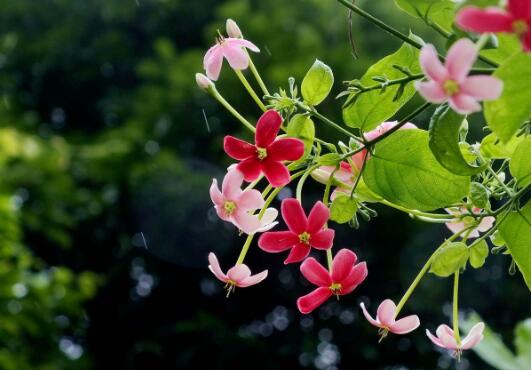What to do with the growth of insects? disease and pest control of Cymbidium / 3 insects and 3 diseases
As the best of orchids, the efficacy of Magnolia is very powerful, it not only has the ability to absorb formaldehyde, but also more beautiful than ordinary orchids, but also has a good use in medicine. But in the process of breeding, many flower friends' plants will have the condition of growing insects and getting sick, so what about the growing insects of Cymbidium chinensis? In this regard, the editor summarized the prevention and control of six kinds of common diseases and insect pests, together to have a look.
First, the golden heart hanging orchid long worm, spray with medicine

Although the orchid is not prone to diseases and insect pests, if it is not maintained according to the cultivation method of the orchid, it is easy to have stagnant water in the basin soil, poor ventilation, rotten roots and so on, resulting in the plant still growing and getting sick. As for the golden orchid long worm how to do, in fact, it is very simple, indeed insect pests, and then aimed at spraying can be solved. The specific symptom is the method of prevention and treatment, and let's move on.
II. Prevention and control of diseases and insect pests of Cymbidium
1. Scale insects
Once the golden orchid worm is found, we can consider it to be a shell worm. Because the insect is prone to outbreak in a poorly ventilated environment, it will attach to the leaves and make the leaves lose their luster. Symptoms of damage: the leaves of Cymbidium are yellow, and the plant will die in severe cases.
Control methods: if there are relatively few scale insects, you can wipe off the insects with laundry powder; when the disease and insect pests are long, you can spray with 1000 times the concentration of omethoate, or you can use 50% malathion diluted into 1500 solution for spray control.
2. Aphids
One of the main pests of Cymbidium, it mainly harms leaves and buds, absorbs a lot of juice, resulting in poor plant growth. Because aphids multiply, they are usually found densely packed, not only frightening, but also very disgusting.
Prevention and control methods: a small number of aphids can be removed by rinsing with plant ash on the leaf surface; when aphids are frequent, 40% imidophos is diluted into 1000 times solution and sprayed once every 7-10 days, and the harm can be relieved by continuous spraying for 2-3 times.
3. Whitefly
One of the common pests that invade the orchid, it is small, propagates quickly, parasites on the phloem of the orchid, and absorbs its juice. Whitefly is generally difficult to detect, once it is found to be a large area, when the plant has been sucked away a large amount of juice, very weak.
Control method: once it is determined that it is whitefly, everyone should immediately use medicine to control it. It can be sprayed with 1000 times of imidathion EC or 1000 times of omethoate with a concentration of 40%. The best spraying time is in the early morning when the adult activity of whitefly is weak.
4. Root rot
In the process of breeding, because of the stagnant water in the basin soil and poor ventilation, it will cause the roots of the orchid to rot, thus causing the plant to suffer from root rot. Symptoms: root rot, leaves withered and yellow, until death.
Prevention and treatment methods: when the above symptoms are found, 50% carbendazim wettable powder can be sprayed 500 times, or it can be irrigated directly once a week; when the disease is serious, pull out Magnolia, remove its rotten roots, change soil and basin and replant.
5. Anthrax
One of the common diseases of Magnolia lanceolata mainly occurs under the conditions of high humidity and muggy environment, stagnant water in flowerpots, overdense plant clusters, poor ventilation and so on. Symptoms: the diseased leaves appear yellowish-brown and sunken spots, then expand called dark brown round spots, the leaf tip withered, and then the whole plant dies.
Prevention and treatment: cut off the diseased leaves and burn them centrally to reduce the source of the disease; in severe cases, spray 1000 times of carbendazim or 1000 times of methyl topiramate for antiseptic, which can be effective after 2-3 times.
6. Leaf blight
In the environment with high temperature, high humidity and poor ventilation, Cymbidium will also suffer from leaf blight. Symptoms: the leaves of Magnolia turn yellow at first, then become brown spots, and finally spread to the whole plant.
Prevention and treatment method: when the above symptoms are found, 70% of the concentration of Dysen zinc is diluted into 600 times solution to spray for prevention and treatment, once every 15-20 days, 2-3 this can be effective.
The value of how to control diseases and insect pests of Cymbidium chinensis
Magnolia, evergreen perennial herb, underground has rhizomes, leaves slender, linear lanceolate, center with yellow and white longitudinal stripes, base clasping stem, bright green. How should we control the diseases and insect pests of Magnolia? The following is to tell you about the value of Magnolia and how to control diseases and pests. How to control diseases and insect pests, there are mainly physiological diseases, leaf front end yellowing, fertilizer and water management should be strengthened. Check regularly and wipe off the shell insects and whitefly on the leaves in time. Cymbidium is not easy to suffer from diseases and insect pests, but if the basin soil is stagnant and poorly ventilated, it may not only cause rotten roots, but also cause root rot. Carbendazim wettable powder 500-800 times liquid can be used to irrigate the roots once a week for 2-3 times.
Magnolia prefers warm, humid and semi-shady environment, is not cold-resistant, and is less cold-resistant than ordinary green orchids. It is afraid of high temperature and strong light exposure, and is not resistant to drought, salinity and stagnant water. The suitable temperature for growth is 13 ℃ 28 ℃, and the ambient temperature in winter should not be lower than 7 mol. After Frosts Descent, the lowest temperature in the morning may be close to 4 ℃, which will bring obvious chilling injury to the plant. Although it could not be shown immediately at that time, after moving indoors, due to lack of light, dry air, high room temperature, poor ventilation and other reasons, it is bound to make the chilling-injured plant of Magnolia lanceolata. It shows the characteristics of yellowing green stripes and browning edges on the leaves. However, as long as its fleshy root system has not rotted and died due to cold injury, put it in a place with bright light, control basin soil watering, increase foliar spray, turn the basin and change soil before coming out of the room next spring, and trim away the withered and necrotic leaves at the same time. Strengthen fertilizer and water management, plants can quickly restore exuberant growth. Family pot-raised orchids, in general, are also easy to appear leaf tip dry, leaf gradually lose luster and other phenomena.
The medicinal value of Magnolia lanceolata is of high medicinal value, and the whole grass can be used as medicine. It has the effect of nourishing yin and moistening lung, clearing heat and resolving phlegm, relieving cough and expectorant as well as promoting blood circulation. It can be used to treat fever tube, lung heat or lung yin deficiency, cough, hematemesis and so on. In addition, it can also be taken to treat oral diseases such as pharyngitis. Environmental value Cymbidium has a good effect on air purification, it can absorb harmful gases such as carbon monoxide, carbon dioxide, formaldehyde and benzene in the air; in addition, the smell emitted by the orchid can also kill germs in the air.
Jinxin orchid for landscape use is an excellent indoor hanging foliage plant, which can be embedded and planted in roadside stone cracks, or embellished on water stones or tree stump bonsai. The above is the introduction about the value of Magnolia and how to control diseases and insect pests. I hope it can be helpful to everyone.
What about the yellow leaves of Cymbidium chinensis? what about the softness of the leaves?
In the process of breeding, it is inevitable that the leaves are yellow and soft, and so on. What if the leaves of Cymbidium are yellow? What should I do if the leaves of the orchid are soft? Let's take a look at the answer.
What if the leaves of Magnolia turn yellow:
More than 20 days after entering the room, the abnormal phenomenon of yellowing and browning of the leaves appeared, which may be due to the cold injury caused by the temperature under the low eaves.
The hanging orchid likes the humid environment, and the basin soil should always be kept moist. Less watering in winter, basin soil should not be too wet, because the root of the orchid will absorb enough water in a watering, so it has a strong ability to resist drought, too much watering leaves are easy to yellowing.
Golden orchid, sexual preference for warm, humid and semi-shady environment, not cold-resistant, less cold-resistant than ordinary green orchids, afraid of high temperature and strong light exposure, and not resistant to drought, salinity and stagnant water, all of which will cause the leaves of Cymbidium to turn yellow.
Due to lack of light, dry air, high room temperature, poor ventilation and other reasons, the chilling-injured plants are bound to show the characteristics of yellowing green stripes and browning edges on the leaves.
Treatment method: as long as its fleshy root system has not rotted and died because of cold injury, put it in a place with bright light, control basin soil watering, increase foliar spray, turn the basin and change it before coming out of the room next spring, at the same time trim the withered and necrotic leaves, strengthen water and fertilizer management, the plant can quickly restore exuberant growth.
What if the leaves of Magnolia are soft:
The leaves droop and break automatically, which is caused by weak light and frequent watering. The growing environment of curing Cymbidium is mainly semi-overcast, and watering should be controlled, because it is fleshy root system, it is slightly resistant to drought, the control of water can make its leaves short, wide and strong, and the whole sun should be the best light in winter. If the temperature is higher than 26 ℃ in other seasons, it should be managed by semi-shade maintenance.
The suitable temperature for the growth of Cymbidium is 15-25 ℃ and the overwintering temperature is 5 ℃. Hanging orchids like warm and humid climatic conditions, not resistant to cold and heat, should be semi-overcast, afraid of strong light. Suitable for well-drained and fertile sandy soil, not cold-resistant. In early October in the north, the orchid should be put into the room, hung in front of the window or placed on the top of the bookshelf, and the branches and leaves should be sprayed and washed with water close to room temperature every five to seven days.
More information
- Prev

How to do the dragon spitting beads long insects? pest control of dragon spitting beads / 2 insect pests 2 diseases
When we breed dragon spitting beads, the last thing we want to encounter is diseases and insect pests, this kind of problem is very harmful to the plant, which will not only affect its ornamental, but also lead to plant death. What about the dragon spitting beads and growing bugs? How to prevent and control diseases and insect pests of dragon spitting beads? Next, the editor will take you to learn about it.
- Next

What are the common diseases and insect pests of a gentleman? to make a gentleman's disease and insect pest control / 2 insect pests 3 diseases
In the process of making a gentleman's growth, the last thing we want to encounter is diseases and insect pests. This kind of problem is extremely harmful to the plant, and it will do great harm to the plant if it is not dealt with in time. So what are the common diseases and insect pests that make a gentleman? What do you need to do to make a gentleman's pest control?
Related
- Fuxing push coffee new agricultural production and marketing class: lack of small-scale processing plants
- Jujube rice field leisure farm deep ploughing Yilan for five years to create a space for organic food and play
- Nongyu Farm-A trial of organic papaya for brave women with advanced technology
- Four points for attention in the prevention and control of diseases and insect pests of edible fungi
- How to add nutrient solution to Edible Fungi
- Is there any good way to control edible fungus mites?
- Open Inoculation Technology of Edible Fungi
- Is there any clever way to use fertilizer for edible fungus in winter?
- What agents are used to kill the pathogens of edible fungi in the mushroom shed?
- Rapid drying of Edible Fungi

